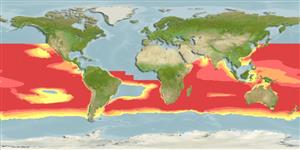Elasmobranchii (haaien en roggen) (sharks and rays) >
Squaliformes (Sleeper and dogfish sharks) >
Dalatiidae (Sleeper sharks)
Etymology: Euprotomicrus: eu-, a Greek intensive (i.e., very); protos (Gr.), first; mikros (Gr.), small, referring to very small first dorsal fin (See ETYFish); bispinatus: bi-, from bis (L.), two; spinatus (L.) thorny, referring to spiny processes on each pelvic fin (claspers) of the male (See ETYFish).
More on authors: Quoy & Gaimard.
Environment: milieu / climate zone / depth range / distribution range
Ecologie
marien bathypelagisch; diepte 0 - 1800 m (Ref. 31367). Deep-water; 38°N - 54°S
Circumglobal: In subtropical to temperate waters. Southeast Atlantic: near Ascension Island, east of Fernando de Noronha Island, and west of Cape of Good Hope, South Africa. Indian Ocean: Madagascar to Western Australia. North Pacific: Midway Islands, Hawaiian Islands to off California, USA. South Pacific: between New Zealand, Phoenix Island and southern Chile.
Lengte bij maturiteit / Grootte / Gewicht / Leeftijd
Maturity: Lm 22.5, range 22 - 23 cm
Max length : 30.5 cm TL mannelijk / geslacht onbekend; (Ref. 96339)
Dorsale stekels (totaal) : 0; Anale stekels: 0. Small dogfish with a cigar-shaped body, a distinct dark collar marking around the gill region, a conical snout, large round eyes (Ref. 5578), fleshy lips, enlarged triangular lower teeth, equal-sized gill slits (Ref. 5578), very small dorsal fins, and a paddle-shaped caudal fin with nearly symmetrical upper and lower lobes (Ref. 6871). Black with white fin edges; belly luminous (Ref. 247).
Epi-, meso-, and perhaps bathypelagic at 1->400 m (Ref. 58302). Occurs at or near the surface at night, descending to below 400 m (possibly as deep as 1,800 m) during the day (Ref. 31367). Feeds on squid, bony fishes, and crustaceans (Ref. 5578). Ovoviviparous (Ref. 205), with 8 young per litter, size at birth between 6 and 10 cm (Ref. 247). Caught with dip-nets and buckets at night (Ref. 6577).
Ovoviviparous, with 8 young per litter. Size at birth between 6 and 10 cm (Ref. 247). Distinct pairing with embrace (Ref. 205).
Compagno, L.J.V., 1984. FAO Species Catalogue. Vol. 4. Sharks of the world. An annotated and illustrated catalogue of shark species known to date. Part 1 - Hexanchiformes to Lamniformes. FAO Fish. Synop. 125(4/1):1-249. Rome, FAO. (Ref. 247)
Status op de Rode Lijst van het IUCN (Ref. 130435: Version 2024-2)
Gevaar voor de mens
Harmless
Gebruik door de mens
Visserij: van geen belang
Tools
Speciale rapporten
Download XML
Internetbronnen
Estimates based on models
Preferred temperature (Ref.
123201): 5.7 - 15.3, mean 9.2 °C (based on 870 cells).
Fylogenetische diversiteitsindex (Ref.
82804): PD
50 = 1.0020 [Uniqueness, from 0.5 = low to 2.0 = high].
Bayesian length-weight: a=0.00309 (0.00142 - 0.00675), b=3.14 (2.94 - 3.34), in cm total length, based on LWR estimates for this (Sub)family-body shape (Ref.
93245).
Trofisch niveau (Ref.
69278): 4.1 ±0.4 se; based on diet studies.
Weerstandsvermogen (Ref.
120179): Zeer laag, minimale populatieverdubbelingstijd meer dan 14 jaar (Fec=8).
Fishing Vulnerability (Ref.
59153): Low vulnerability (21 of 100).
